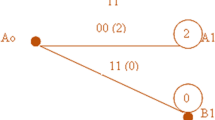Abstract
In a coded cooperation scheme, the relay must decode and re-encode data. This process needs to be completed rapidly. Therefore, a simple channel coding/decoding scheme that requires low computational loads is needed. Reed–Solomon (RS) codes are simple, forward error-correction codes with low decoding computational loads. This paper introduces a three-user RS coded cooperation scheme that aims to have simple encoding/decoding complexity as well as to increase diversity order. It also presents the mathematical derivations of outage probability and investigates the outage performance of the three-user RS coded cooperation scheme. The derived outage probability expressions prove that the three-user RS coded cooperation scheme can achieve full diversity. Numerical bit error rate comparisons show that the three-user RS coded cooperation scheme performs better than a two-user scheme under various inter-user and uplink channel conditions. Outage probability performance improves at approximately 5 dB for regions with low signal-to-noise ratio (SNR) and 10 dB for regions with high SNR under a slow-fading channel. The paper also presents the complete calculated numerical tables for outage probability terms (integral terms) that do not have closed-form solutions.









Similar content being viewed by others
References
Nosratinia, A., Hedayat, A., & Hunter, T. E. (2004). Cooperative communication in wireless networks. IEEE Communication Magazine, 42, 74–80.
Sendonaris, A., Erkip, E., & Aazhang, B. (2003). User cooperation diversity. Part I. System description. IEEE Transactions on Communications, 51(11), 1927–1938.
Laneman, J. N., Tse, D. N. C., & Wornell, G. W. (2004). Cooperative diversity in wireless networks: Efficient protocols and outage behavior. IEEE Transactions on Information Theory, 50, 3062–3080.
Van Khuong, H., & Le-Ngoc, T. (2009). A cooperative turbo coding scheme for wireless fading channels. IET Communications, 3(10), 1606–1615.
Menghwar, G. D., & Mecklenbrauker, C. F. (2009). Outage performance of two users cooperative network coding. In 9th international symposium on communications and information technology (ISCIT 2009), pp. 1180–1184.
Jittilertwirun, C., Ahmed, K. M., & Premanandana Rajatheva, R. M. A. (2006). Performance of two-user cooperation in frequency selective Rayleigh fading channel. In Proc 1st international symposium on systems and control in aerospace and astronautics (ISSCAA 2006), pp. 826–827.
Hunter, T. E., & Nosratinia, A. (2006). Diversity through coded cooperation. IEEE Transactions on Wireless Communications, 5(2), 283–289.
Hong, W., Liang, Z., & Zhongpei, Z. (2006). Cooperative coding using parallel concatenated LDPC codes. In IEEE information theory workshop, 2006, pp. 395–398. ITW ’06 Punta del Este.
Reed, I., & Solomon, G. (1960). Polynomial codes over certain finite fields. Journal of the Societyfor Industrial and Applied Mathematics, 8, 300–304.
Almawgani, A. H. M., & Salleh, M. F. M. (2010). Coded cooperation using reed Solomon codes in slow fading channel. IEICE Electronics Express, 7(1), 27–32.
Almawgani, A. H. M., & Salleh, M. F. M. (2010). Outage probability of coded cooperation for slow fading channel. IEICE Electronics Express, 7(18), 1388–1395.
Hunter, T. E., Sanayei, S., & Nosratinia, A. (2006). Outage analysis of coded cooperation. IEEE Transactions on Information Theory, 52(2), 375–391.
Author information
Authors and Affiliations
Corresponding author
Appendix: Numerical Tabulation for Outage Probability
Appendix: Numerical Tabulation for Outage Probability
The values in Tables 4 and 5 (as shown below) are obtained based on computer programs. These tables offer a quick method for obtaining the numerical values for the outage probability in Eq. (15) without performing long calculations of the integrals. These tables are also used to construct Fig. 10. Instead of referring to the tables to determine the outage probability values, Fig. 10 may be used as reference. This figure is constructed by considering the symmetrical property along the main diagonals in Tables 4 and 5. Thus, this figure may be used to determine the value of \(\varphi _4 \) and \(\varphi _7 \) at any \(\textit{SNR}_{1}\) and \(\textit{SNR}_{2}\). The paragraph below explains the usage of the outage probability tables and figures to obtain the numerical value of the outage probability in Eq. (15) without using computer programs.
The values of \(\varphi _4\) and \(\varphi _7 \) are obtained from Fig. 10 below, whereas that of \(\varphi _{12} \) is obtained from Fig. 11 below. The value of \(\varphi _{15}\) is obtained from Fig. 12 below. These values are for \({\textit{SNR}}_{1,BS} , {\textit{SNR}}_{2,BS} \), and \({\textit{SNR}}_{3,BS} \).
Assuming all SNR channels are equal to 20 dB;
Thus,
From Fig. 10, \(\varphi _4 =5.5\times 10^{-5}\) and \(\varphi _7 =1.1\times 10^{-4}\)
From Fig. 11, \(\varphi _{12} =2\times 10^{-7}\), and
From Fig. 12, \(\varphi _{15} =4\times 10^{-7}\).
Thus,
This calculated value is the exact value obtained from Fig. 6. From this figure, at 20 dB SNR for the inter-user and uplink channels, the outage probability obtained is equal to \(6\times 10^{-6}\). The numerical value of the outage probability may now be calculated without running a computer program because the integral terms in the outage probability expressions do not have a closed-form solution (Table 6).
In Table 7, looking at the secondary diagonals (top right to bottom left), all values of \(\varphi _{12} \times 10^{-4}\) are approximately equal. The summation for \(SNR_{1 }\) and \(SNR_{2}\) always results in a constant value for every path. Thus, the whole table may be represented using only one main diagonal number. This technique may be repeated for \(\varphi _{12} \) and \(\varphi _{15} \). The value of \(SNR_{3}\) may also be changed with the appropriate values. The results will be similar to those plotted in Figs. 11 and 12.
Rights and permissions
About this article
Cite this article
Almawgani, A.H.M., Salleh, M.F.M. Outage Probability Analysis of Three-User Reed–Solomon Coded Cooperation Scheme for Wireless Slow Fading Channel. Wireless Pers Commun 72, 919–940 (2013). https://doi.org/10.1007/s11277-013-1047-6
Published:
Issue Date:
DOI: https://doi.org/10.1007/s11277-013-1047-6







